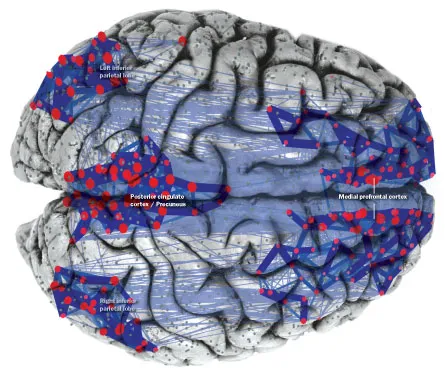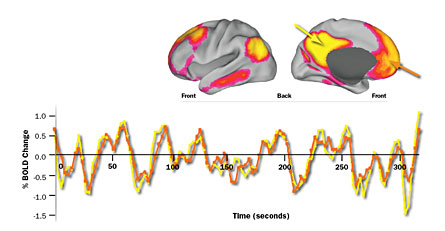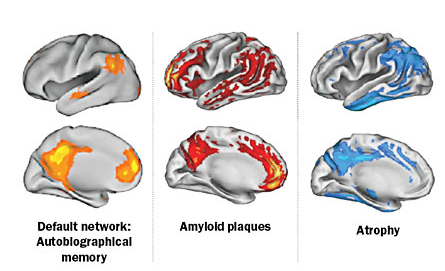You Are Who You Are by Default
It may be off when you’re on, but the brain network behind daydreams and a sense of self is no slacker
- More than 2 years ago
You may not be riding the latest social wave on Facebook or MySpace, or tweeting your every impulse to fans on Twitter. But your brain is hooked on networking.
Vision works because different brain regions link up to connect the dots of light and color into a meaningful picture of the world. Language depends on networks of neural circuitry that make sense of the words you hear or see and that help you generate your side of the conversation. Networks of nerves control the motion of your muscles, allowing you to move smoothly and, when necessary, swiftly.
Networks are the “in” thing for brain scientists, as surely as they have been for online social butterflies.
Scientists learn about the brain’s networks by asking people to perform all sorts of mental acrobatics — interpreting optical illusions, solving riddles, taking tests of mental or muscular skills. But some neuroscientists think they can learn even more about the brain by asking volunteers to just lie back, close their eyes and let their minds wander.
Such unstructured journeys of the mind — be they planning tonight’s dinner, thinking about that meeting at work and what your boss said afterward, debating whether to drive or fly for your next vacation, or recalling that day in your childhood when you first sat in your new tree house listening to birds chirp —turn out to offer clues about one of the most important, mysterious and well-connected networks of all. It’s called the default mode network, and it’s responsible for what the brain does when it is doing nothing in particular. It’s the brain’s core, both physically and mentally, and it’s better connected to the brain’s system of circuits than Kevin Bacon is to movie stars.
“I think the default mode network is the most exciting thing that has happened in cognitive neuroscience in quite some time,” says Peter Fransson, a neuroscientist at the Karolinska Institute in Stockholm.
Default brain settings may lead to daydreaming and mind-wandering, but the network also conducts serious business. Neuroscientists still hotly debate the network’s exact functions, however. Among its jobs may be running life simulations, providing a sense of self and maintaining crucial connections between brain cells. A few researchers doubt the network is anything special at all.
But evidence suggests that a malfunctioning default network is involved in diseases and disorders as diverse as Alzheimer’s disease, autism, depression, post-traumatic stress disorder, Tourette syndrome, amyotrophic lateral sclerosis, schizophrenia and attention-deficit/hyperactivity disorder.



Busy behind the scenes
Despite its laid-back name, which neuroscientist Marcus Raichle coined in a 2001 paper, the default mode network is one of the hardest-working systems in the brain. It was discovered accidentally by researchers watching the activity of brains at work on various tasks.
Neuroscientists use PET (short for positron emission tomography) and functional MRI scanners to image and gauge brain activity. To tell which areas of the brain become more active during a mental task, scientists compare brain activity during the task with activity when the person is at rest, either with eyes closed or while staring at a dot or cross. Raichle, of Washington University in St. Louis, and others saw that every time a person engaged in a mental activity such as memorizing a list of words, a collection of brain regions consistently decreased activity compared with their resting levels. Only when people recall autobiographical memories or imagine alternative situations is the network more active than it is at rest, scientists have since found. (In this context, “rest” refers to a state in which the brain is not engaged in a mental task but is still monitoring the body and the world around it.) Raichle hypothesized that the network is more active when the brain is at rest and has to dial back its activity to let people concentrate on specific tasks.
Michael Greicius, a neurologist and neuroscientist at the Stanford School of Medicine, put the resting part of Raichle’s
theory to the test. Greicius and his colleagues measured brain activity while volunteers had their eyes closed and thought of nothing in particular. The team used a technique called functional connectivity MRI to reveal correlations in activity in different brain areas. The group reported in 2003 that blood flow in parts of the brain implicated in the default network rises and falls like the tides — in slow but synchronized waves.
Those coordinated parts of the brain — with cumbersome names such as the medial prefrontal cortex, posterior cingulate cortex, retrosplenial cortex, precuneus, inferior parietal lobe and hippocampus — are located mostly along the crevice separating the brain’s hemispheres, and on each lobe behind and above the ears. Researchers don’t agree on all the components of the default network, but consensus is growing that it has two major hubs: the posterior cingulate cortex, or PCC, with the precuneus, and the medial prefrontal cortex.
Functions ascribed to those two areas may give clues to what the default network is good for. The medial prefrontal cortex is involved in imagining, thinking about yourself and “theory of mind,” which encompasses the ability to figure out what others think, feel or believe and to recognize that other people have different thoughts, feelings and beliefs from you. The precuneus and PCC are involved in pulling personal memories from the brain’s archives, visualizing yourself doing various activities and describing yourself.
Together, these hubs give you a sense of who you are. Their prominence in the network has led some researchers to propose that the function of the default mode is to allow you to internally explore the world and your place in it, so you can plot future actions, including contingency plans for various scenarios you might encounter.
The network that never sleeps
Some scientists quibble with the name, but Fransson says the network really is the brain’s default. Peter Williamson, a psychiatrist at the University of Western Ontario in London, Canada, agrees.
“You don’t even have to be conscious for it to be apparent,” he says.
Slow yet coordinated fluctuations in activity bind the network together. The syncopations continue even while people are asleep, under anesthesia or in comas. But it is unlikely that such activity reflects ongoing conscious processing, Greicius contends. The fluctuations that move through the network are incredibly slow, he says, with one cycle every 15 to 20 seconds. Most conscious thought happens in split seconds, so it is more likely that the plodding pulses are for “subconscious synapse maintenance,” he says.
Synapses are the connections between neurons where cell-to-cell communication takes place. When two neurons stop “talking” to each other, connections between them can be severed. Greicius thinks the low-level fluctuations in the network help keep the neurons in contact, sort of the brain-cell equivalent of Facebook status updates.
While it is good to stay connected, reverting to default isn’t always helpful. The default mode network sometimes stirs during monotonous tasks, drawing away a person’s attention. Such reactivation of the network predicted errors up to 30 seconds before a person made a mistake, Vince Calhoun of the MIND Research Network in Albuquerque and colleagues reported in 2008 in the Proceedings of the National Academy of Sciences. And a study published May 26 in that journal, by Kalina Christoff of the University of British Columbia in Vancouver, Canada, and colleagues, shows that not only is the default network involved in mind-wandering, it also distracts executive areas of the brain, so that people aren’t even aware that their minds have wandered off task.
Psychiatric connections
Researchers are also studying how defects in the coordination between different parts of the default network may contribute to psychiatric disorders. Calhoun, an electrical engineer at the University of New Mexico, and colleagues at other institutions studied network activity during a memory task in 115 people with schizophrenia and 130 healthy people. Some subnetworks within the default mode network had trouble disengaging in people with schizophrenia, impairing their ability to focus on the task, the team reported online May 11 in Human Brain Mapping.
People with schizophrenia also have faster cycles of activity in their default networks during a resting state than healthy people do, Calhoun and another group of colleagues reported in the March 2007 American Journal of Psychiatry.
Williamson and colleagues, meanwhile, have shown that the default network’s connections with other parts of the brain may be important in determining who develops PTSD after a traumatic event. People who have been traumatized can become numb and lose their sense of self, Williamson says. The researchers examined default networks in women who developed PTSD after trauma in childhood. The study found altered levels of connectivity among parts of the default network as well as between the network and other parts of the brain. The findings, published in May in the Journal of Psychiatry & Neuroscience, could indicate that trauma creates disturbances in the network’s ability to create a sense of self.
The default network may also be the launching point for Alzheimer’s disease’s assault on the brain. The characteristic plaques of the disease deposit preferentially in the brain regions most associated with the network, studies have shown. And Greicius and his colleagues reported online last year in the June 2008 PLoS Computational Biology that activity in the default network is affected by the disease.
At least one study suggests that the default network may be vulnerable to Alzheimer’s disease decades before symptoms or plaques show up. Young people who carry a genetic risk factor for the disease have more activity in the default network, particularly in the hippocampus, than young people who don’t have the genetic risk, researchers from Oxford University and Imperial College in England reported in the April 28
Proceedings of the National Academy of Sciences. The authors say the study provides evidence for the theory that the default network’s constantly high activity eventually burns it out, leaving it vulnerable to Alzheimer’s disease.
Greicius says he isn’t a fan of this “use it and lose it” theory. Other networks in the brain also burn a lot of energy, even at rest, but they don’t fall prey to Alzheimer’s disease. Instead, Alzheimer’s and four other neurodegenerative diseases each target a different brain network, Greicius and colleagues including William Seeley of the University of California, San Francisco discovered. The results, published April 16 in Neuron, could mean that neurons that fire together die together. The researchers don’t yet understand why. It could be that when a neuron dies, its silence triggers death in neighboring neurons, or neuron-killing substances might pass from one cell to another through synapses, Greicius says.
Blueprint for the brain
To understand what goes wrong with the default network to lead to psychiatric disorders, scientists need to understand how the network is built. Assembling disparate regions of the brain into a coordinated, coherent system surely is no simple task for the developing brain.
“One might imagine that the development of self might take a bit of time to sculpt,” Raichle says.
Only a few studies have been done with children, so the picture of the nascent default network is about as clear as an ultrasound image is to someone other than an expectant parent. But new ways of analyzing neural connections are bringing the picture into better focus.
Fransson and his colleagues used fMRI to scan the brains of sleeping premature infants who had reached the equivalent of 40 weeks of gestation to see whether the default network is already in place when babies are first born. The researchers could not find evidence that the default mode is operational in newborns, although five other brain networks are already online, the team reported in 2007. Fransson says he is not surprised that newborns lack a network that draws on personal experience and dreams of what is to come.
“Infants cannot plan for their futures,” he says. “They don’t think about their pasts.”
But a recent study by Weili Lin, a
neuroscientist at the University of North Carolina at Chapel Hill, and colleagues shows that infants as young as 2 weeks have rudimentary, incomplete default mode networks. The study, published in the April 21 Proceedings of the National Academy of Sciences, tracks development of the network from shortly after birth into toddlerhood. Newborns’ default networks connect six brain regions, Lin’s group found.
It doesn’t take long for the brain to develop a default mode, Lin showed. By age 1, babies link 13 brain regions in their default network, including 10 parts found in the adult network. In 2-year-olds, the default network is even bigger, comprising 19 regions, 13 consistent with the network in adults. But bigger networks can also be inefficient, Lin says, noting that adult default networks have been pruned of extraneous connections.
Lin and his colleagues are continuing to scan many of the children in the study as they age to track how the normal brain develops. Preliminary data from 4-year-olds indicate that extra connections are severed as the brain ages, he says.
A group of researchers at Washington University including Raichle, Steven Petersen, Bradley Schlaggar and Damien Fair (now at the Oregon Health & Science University) are piecing together the network’s development from age 7 into early adulthood.
Brain connections in 7-year-olds are organized differently than in adults. Children have more short-range connections among neighboring brain regions and fewer long-range connections, particularly among the parts of the default network in the back and front, the team reported last year in the Proceedings of the National Academy of Sciences. As children age, the connections are rewired. Adolescents have a network structure somewhere between that of elementary-age children and adults.
“It’s like different cliques of friends in childhood break up and create different cliques in adulthood,” Petersen says.
Given the lack of long-range connections in children’s brains, researchers were surprised to discover that kids’ default networks aren’t clunky. The team mapped how the brain makes connections in the network, a neuroscience version of the game to link actor Kevin Bacon to other actors in Hollywood through people with film appearances in common. Fewer steps means more efficient connections. While children’s connections are structured differently, they have enough shortcuts to make information transfer in the network just as efficient as in adults, the
scientists reported online May 1 in PLoS Computational Biology.
Once people reach adulthood, activity in the network is fairly consistent from person to person, with some slight differences between the sexes and in older versus younger people, Williamson and his colleagues wrote in a 2008 paper in NeuroReport.
This consistency in the network from person to person is remarkable, especially considering what its function is supposed to be. Everyone’s brain is thinking different thoughts while in the default mode, Fair says, and yet all healthy brains in default mode look essentially alike.
Such fundamental issues are among the puzzles of the default network remaining to be solved.
“Nobody has really figured out what it is and what it does,” Williamson says. “But somebody will.”
Wandering and wondering
The brain’s default mode network — a series of connected areas that work hardest when most of the brain is at rest —is active during daydreaming and mind-wandering. The network may also be involved in imagining how certain situations play out and in giving people their sense of self and where they fit in the world. Many scientists believe the default network has two major hubs, one in the posterior cingulate cortex with the precuneus and one in the medial prefrontal cortex. The two hubs are highlighted in the image above, which shows a human brain viewed from the top and overlaid with a computer-generated map showing the most robust of the network’s structural connections. Also visible in the map are the left and right inferior parietal lobes, which are among a number of other brain regions involved in the default network.
Network in sync
At top, fMRI images show areas of the brain that coordinate activity when people are thinking about nothing in particular. The left image shows the outside of a left-facing brain. The right image shows the inner surface of one hemisphere of a right-facing brain. Activity in the two major hubs of the default network (indicated by yellow and orange arrows) rises and falls in time with each other, as seen on a plot of those fluctuations below.
Alzheimer’s overlaps default network
Alzheimer’s disease appears to particularly affect brain areas involved in the default network. At left, two views of the brain show areas activated (orange) when a healthy person recalls personal memories. Amyloid plaques characteristic of Alzheimer’s accumulate (red) and the brain atrophies (blue) in some of the same areas, as shown in scans of people with dementia (middle and right).







